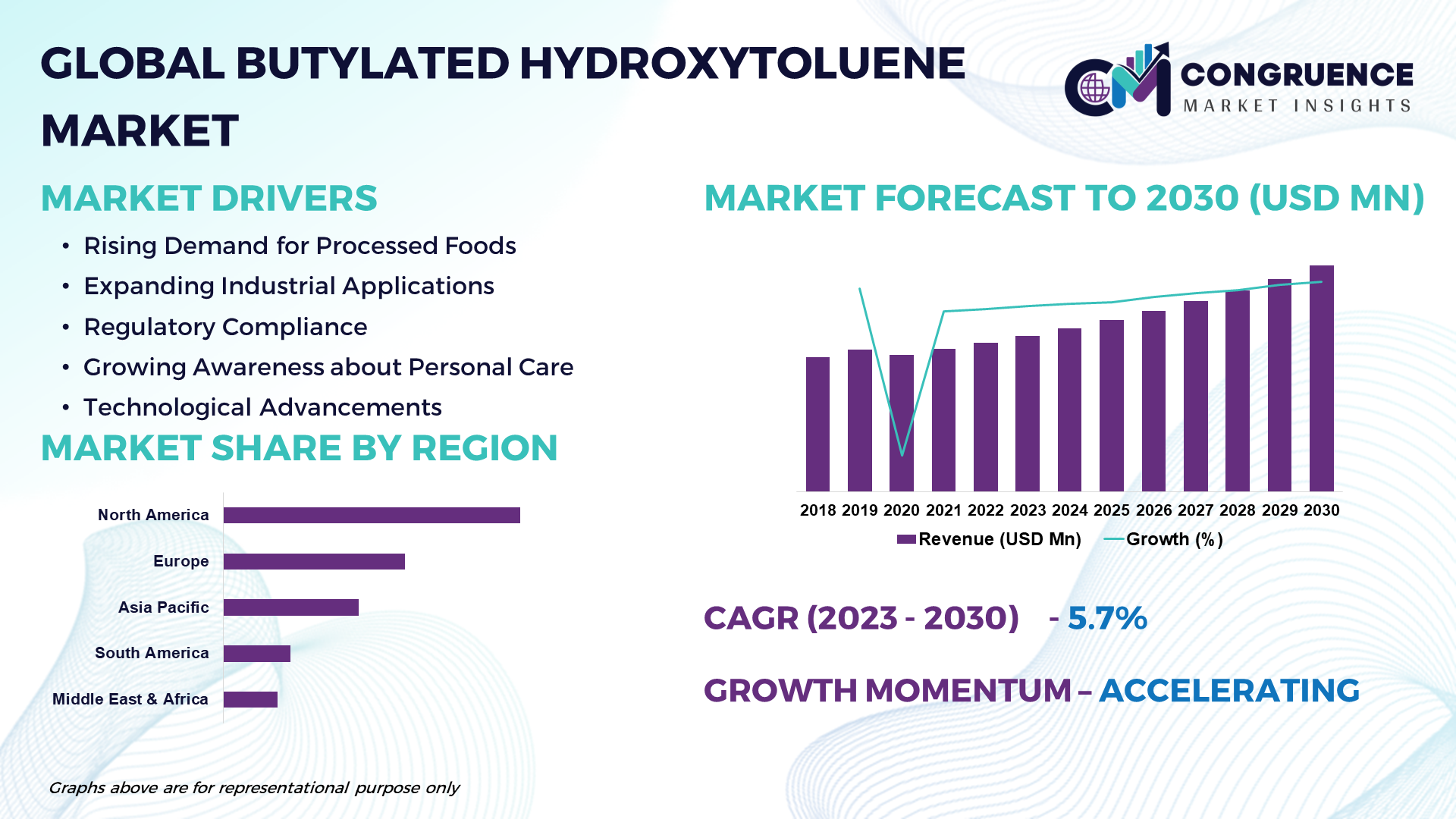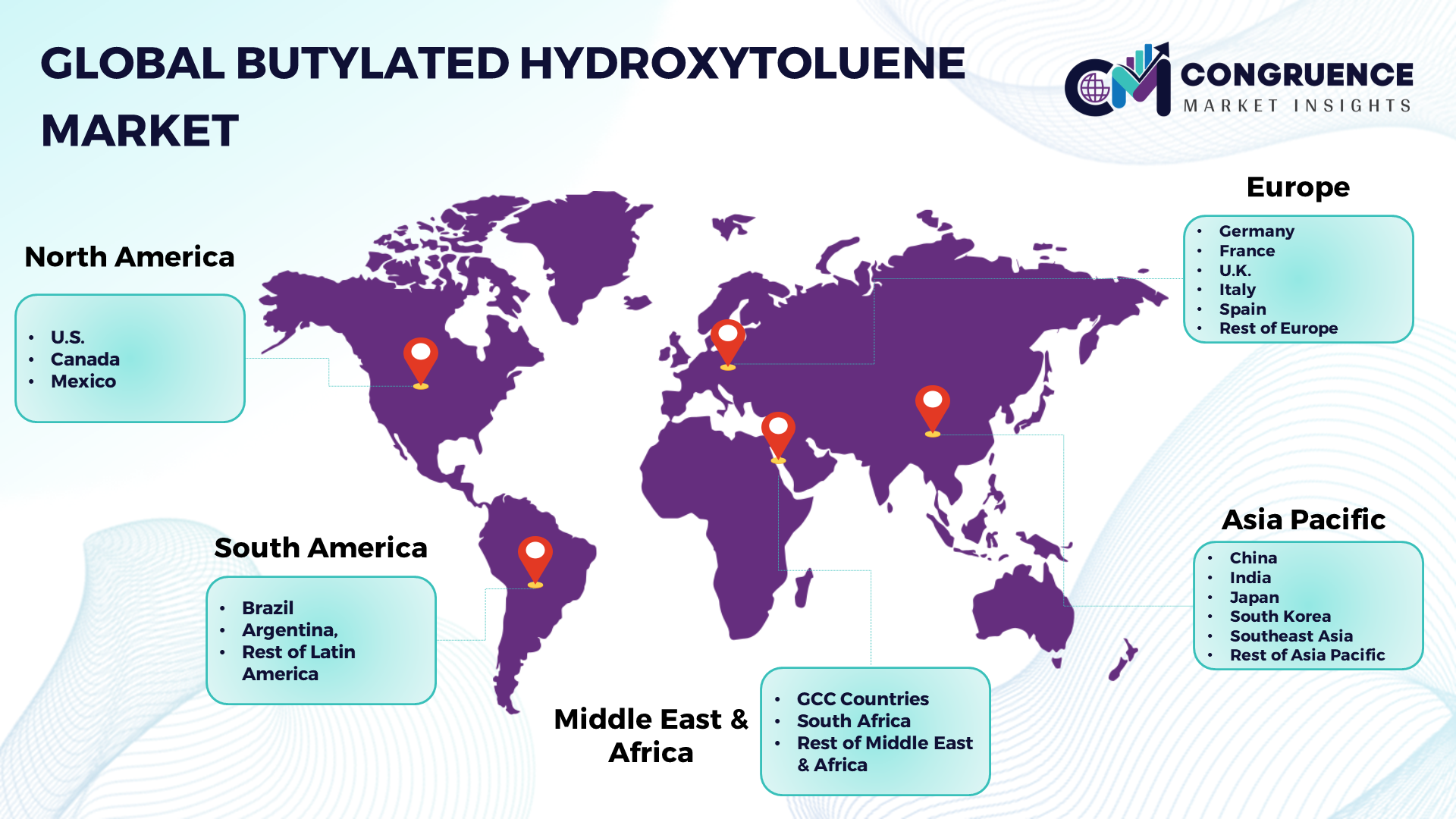Reports
The Global Butylated Hydroxytoluene Market is expected to witness significant growth, projected to expand at a CAGR of 5.7% from 2023 to 2030. Butylated Hydroxytoluene (BHT) is a synthetic antioxidant widely used across industries for its ability to prevent oxidation and extend product shelf life. Found in various applications including food and beverages, pharmaceuticals, cosmetics, animal feed, and industrial additives, BHT plays a crucial role in maintaining product quality and stability by inhibiting the formation of free radicals. The market for BHT is primarily driven by the increasing demand for processed foods, rising awareness of the benefits of antioxidants in pharmaceuticals and cosmetics, and the expanding industrial sector. With consumers seeking safer and longer-lasting products, BHT serves as a key ingredient in preserving the integrity of a wide range of goods. This growth is fueled by ongoing innovations in BHT applications, coupled with emerging trends in sustainability and regulatory compliance. As industries continue to prioritize product quality and safety, the demand for BHT as a reliable antioxidant solution is expected to soar, presenting lucrative opportunities for manufacturers and suppliers in the global market.

Butylated Hydroxytoluene Market Major Driving Forces
Rising Demand for Processed Foods: The growing consumption of processed and packaged foods, coupled with increasing concerns regarding food spoilage and quality, is driving the demand for BHT as a food preservative.
Expanding Industrial Applications: BHT is widely utilized in industrial sectors such as plastics, rubber, and petroleum products for its antioxidant properties, thereby fueling market growth.
Regulatory Compliance: Stringent regulations regarding food safety and quality standards mandate the use of antioxidants like BHT in food products, driving market demand.
Growing Awareness about Personal Care: BHT is used in personal care products such as cosmetics and toiletries for its antioxidant and preservative properties, contributing to market growth in the personal care segment.
Technological Advancements: Ongoing research and development efforts to enhance the efficacy and safety of BHT formulations are driving market growth and adoption across various industries.
Butylated Hydroxytoluene Market Key Opportunities
Clean Label Trends: The growing consumer preference for clean label and natural products presents opportunities for manufacturers to develop natural alternatives or formulations with reduced BHT content, catering to health-conscious consumers.
Expansion in Pharmaceutical Applications: The pharmaceutical industry's increasing demand for antioxidants in drug formulations and healthcare products offers opportunities for BHT manufacturers to expand their presence in this sector.
Emerging Markets: The rising demand for packaged foods and personal care products in emerging markets presents untapped opportunities for BHT manufacturers to expand their market reach and capitalize on growing consumer demand.
Product Innovation: Continued research and development to improve BHT formulations, enhance efficacy, and explore new applications can drive market growth and differentiation in competitive markets.
Sustainability Initiatives: The adoption of sustainable practices and eco-friendly formulations in food, personal care, and industrial applications presents opportunities for BHT manufacturers to develop environmentally friendly alternatives and address growing consumer concerns.
Butylated Hydroxytoluene Market Key Trends
· Clean Label Formulations: The demand for clean label and natural products is driving the development of BHT-free or reduced BHT formulations in food, personal care, and pharmaceutical applications.
· Antioxidant Blends: Formulations combining BHT with other antioxidants or natural preservatives are gaining traction, offering enhanced antioxidant properties and improved product stability.
· Pharmaceutical Grade BHT: The pharmaceutical industry's increasing demand for high-purity BHT for drug formulations is driving the production of pharmaceutical-grade BHT to meet stringent quality standards.
· Functional Food and Nutraceuticals: The incorporation of BHT into functional food and nutraceutical products for its antioxidant properties is a growing trend, driven by consumer interest in health and wellness.
· Regulatory Compliance: Compliance with stringent regulatory standards regarding the use of antioxidants in food, personal care, and pharmaceutical products is a key trend influencing market dynamics and product formulations.

Market Competition Landscape
The global Butylated Hydroxytoluene (BHT) market is characterized by intense competition among key players striving to gain a competitive edge through product innovation, strategic partnerships, and expansion into emerging markets. Major players in the market focus on research and development activities to enhance product efficacy, meet regulatory requirements, and address evolving consumer preferences. Prominent companies operating in the global BHT market include:
· Eastman Chemical Company
· LANXESS
· SI Group, Inc.
· Sasol Limited
· Merck KGaA
· Hansa Group AG
· LyondellBasell Industries Holdings B.V.
· Archer Daniels Midland Company
· OXEA GmbH
· BASF SE
· Apexical, Inc.
· Kemin Industries, Inc.
· Vanderbilt Chemicals, LLC
|
Report Attribute/Metric |
Details |
|
Base Year |
2022 |
|
Forecast Period |
2023 – 2030 |
|
Historical Data |
2018 to 2022 |
|
Forecast Unit |
Value (US$ Mn) |
|
Key Report Deliverable |
Revenue Forecast, Growth Trends, Market Dynamics, Segmental Overview, Regional and Country-wise Analysis, Competition Landscape |
|
Segments Covered |
· By Application (Food & Beverages, Pharmaceuticals, Cosmetics, Animal Feed, Industrial Additives) · By End-use (Industrial, Commercial) · By Sales Channel (Direct Sales, Distributors) |
|
Geographies Covered |
North America: U.S., Canada and Mexico Europe: Germany, France, U.K., Italy, Spain, and Rest of Europe Asia Pacific: China, India, Japan, South Korea, Southeast Asia, and Rest of Asia Pacific South America: Brazil, Argentina, and Rest of Latin America Middle East & Africa: GCC Countries, South Africa, and Rest of Middle East & Africa |
|
Key Players Analyzed |
Eastman Chemical Company, LANXESS, SI Group, Inc., Sasol Limited, Merck KGaA, Hansa Group AG, LyondellBasell Industries Holdings B.V., Archer Daniels Midland Company, OXEA GmbH, BASF SE, Apexical, Inc., Kemin Industries, Inc., and Vanderbilt Chemicals, LLC |
|
Customization & Pricing |
Available on Request (10% Customization is Free) |
